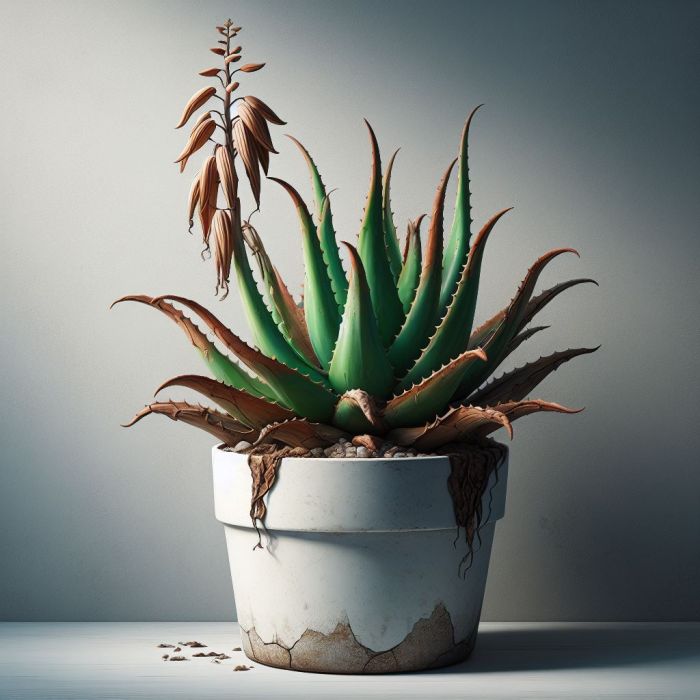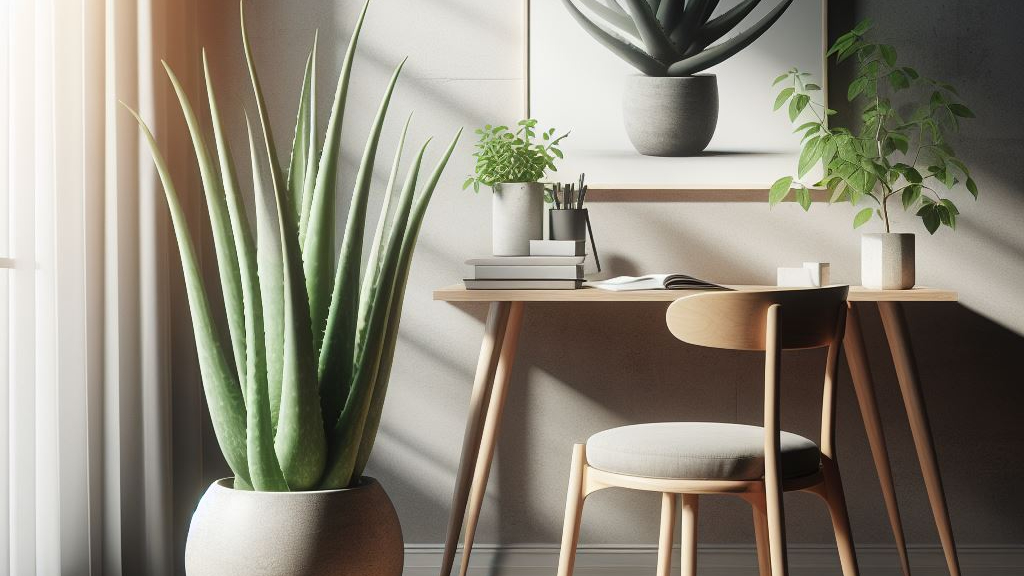Last updated on March 8th, 2024 at 06:35 am
Aloe vera celebrated for its versatility and resilience, can be a prized addition to any plant enthusiast’s collection, whether indoors or outdoors. However, witnessing your aloe plant develop brown discoloration can be disconcerting. Despite their reputation for being easy-going, aloes can face various challenges leading to browning leaves. Identifying the root cause of why my aloe vera plant turning brown is crucial for remedying it and restoring your plant to health. Below, we delve into potential reasons behind your aloe vera turning brown and outline steps to address each issue effectively. Let’s explore these factors in detail:
Contents
- 1 Reasons For Aloe Vera Plant Turning Brown?
- 2 (FAQs)
- 2.1 Why is my aloe vera turning brown?
- 2.2 How can I prevent aloe vera from turning brown due to underwatering?
- 2.3 What should I do if my aloe vera is overwatered and turning brown?
- 2.4 How to protect aloe vera from sunburn and prevent browning?
- 2.5 How can I prevent aloe vera from experiencing cold stress and turning brown?
- 2.6 How to manage pest infestations and prevent aloe vera turning brown?
- 2.7 What measures can prevent aloe vera from turning brown due to environmental stress?
- 3 Author
Reasons For Aloe Vera Plant Turning Brown?

Underwatering:
When observing your Aloe Vera plant turning brown, one possible reason is underwatering. Look for brown, dried tips on the stalks, which indicate dehydration. These symptoms signal that your plant is not receiving adequate moisture to thrive.
Once the tips of aloe stalks have been browned due to dehydration, they cannot be revitalized. However, with proper care, you can prevent further discoloration and restore your plant’s health.
To fix dry plants and prevent more browning, water them generously. Water your aloe vera plant only when the soil has dried out completely. This ensures that moisture reaches the root system effectively. When watering, be generous to ensure adequate hydration throughout the soil.
Establishing a Watering Schedule:
Make a watering schedule according to your aloe vera plant’s needs. Aim to maintain soil moisture without allowing it to become waterlogged. Consistency is key; monitor soil moisture levels regularly to adjust your watering frequency accordingly.
In succulent plants like aloe vera, it’s generally safer to underwater than to overwater. While underwatering can lead to browning and wilting, it’s a less severe issue compared to overwatering, which can be fatal for plants adapted to storing water. Erring on the side of caution minimizes the risk of causing irreparable harm to your beloved aloe.
Overwatering:
When the aloe vera plant turns brown, it’s often indicative of the adverse effects of excessive watering. Aloe vera, being succulents adapted to dry climates, thrive with infrequent watering. Overwatering can lead to root rot, displaying as brown, mushy leaves.
Overwatering poses a significant risk to aloe vera plants due to their ability to store moisture in their thick leaves. Brown or yellow discoloration and a soft, mushy texture are signs of overwatering, signaling potential root rot.
Corrective Actions:
To counteract overwatering and revive your aloe, stop watering immediately and allow the soil to dry out thoroughly. Prune affected leaves using a sterilized blade to prevent further decay.
Ensure drainage by repotting your aloe vera plant into a terra cotta container, renowned for its moisture-wicking properties. Choose a well-draining potting mix enriched with coarse sand or perlite to promote better soil aeration and drainage.
Water your plants carefully and avoid overwatering. allowing the soil to dry completely between waterings. Regularly monitor drip trays and saucers to prevent water accumulation around the roots.
Sunburn:
The reason for the aloe vera plant turning yellow is sunburn, a consequence of prolonged exposure to intense sunlight. Sunburn exhibits dark brown or bleached spots on the leaves, indicating damage caused by excessive sunlight.
To counteract sunburn on your aloe plant, consider relocating it to an area with filtered sunlight. Alternatively, provide shade during the hottest periods of the day, especially in spring and summer. This preventive measure aims to shield your aloe vera from the scorching effects of the sun.
Managing Sunburned Aloes:
Sunburned leaves, displaying a dark brown or bleached hue, won’t recover. However, you can promote the growth of undamaged foliage by ensuring your aloe vera is no longer exposed to excessive sunlight. While the affected leaves won’t heal, new growth will emerge safely.
For ongoing protection, incorporate a routine of shading your aloe plant during the sun’s peak hours. This proactive step helps prevent further sunburn and promotes the overall health of your aloe.
Managing Cold Stress: Shielding Aloe Vera Plant Turning Browning
Aloes, renowned for their hardiness, are nevertheless sensitive to cold temperatures, making them prone to damage when exposed to frost or chilly drafts. Cold stress often presents as brown spots or discoloration on the leaves, signaling potential harm to your aloe plant.
It’s common for aloe vera plants to exhibit browning following exposure to cold nights, catching owners off guard if precautions aren’t taken. Aloe vera typically withstand temperatures down to about 40°F. When subjected to cold without protection, plants may develop dark brown or blackened spots, accompanied by leaf softening and wilting.
Responding to Cold Damage in Aloe Plants:
Unfortunately, cold-induced damage is irreversible. If your aloe has suffered from exposure to cold, swiftly relocate it to a warm indoor environment to prevent further harm. While completely frozen plants may not recover, those affected by frost damage can be solved with patience. Prune wilted leaves and diligently care for the plant to encourage new growth.
To shield your aloe vera plant from turning brown from cold stress, proactively take steps such as bringing potted plants indoors during winter or providing substantial protection for in-ground specimens. Utilize horticultural fleece or blankets to safeguard plants when temperatures drop below 50°F (10°C).
Pest Management: Shielding Aloe Vera Plant Turning Brown
Aloe vera plants often deemed resilient, can succumb to pests like mealybugs, scale insects, and spider mites, which feed on their sap and induce leaf damage. Look for telltale signs such as brown spots or sticky residue on the foliage, indicating the presence of these harmful pests.
Similar to diseases, pests can cause brown or spotty discoloration on aloe vera leaves. Infestations tend to target weakened plants, worsening their condition. If your aloe vera suddenly deteriorates in health, pests or diseases are likely culprits deserving attention.
Strategies for Pest Control and Treatment:
To tackle pests, be proactive. Shake off as many as you can, especially during heavy infestations. Use a treatment spray like neem oil, following the instructions carefully. Act quickly to stop more damage to the plant.
Implementing Preventive Measures:
Preventing pest infestations involves maintaining optimal plant health and adopting effective hygiene practices. Regularly remove dead or diseased leaves, ensure appropriate hydration while avoiding waterlogged conditions, and promote adequate drainage. These actions fortify your plant’s resilience against pests and diseases.
Nutrient Deficiency:
While aloe vera plants generally require minimal fertilization, they can suffer from nutrient deficiencies when grown in poor-quality soil or inadequately fertilized. Insufficient levels of essential nutrients, such as nitrogen or potassium, may lead to the aloe vera plant turning brown or yellowing leaves, indicating a lack of proper nutrition.
Regular fertilization, contrary to popular belief, can lead to aloe vera plant turning brown. Excessive fertilizer application can result in salt formation around the roots, impeding water uptake and transportation within the plant. This disruption in water flow can contribute to leaf browning.
Remedial for Excess Fertilization and Browning:
To overcome the effects of excess fertilizer on your aloe vera plant turning brown, consider leaching the soil using distilled or rainwater. Flush the soil with water twice the volume of your pot to dislodge salt build-ups and facilitate drainage. Limit fertilizer application to once a year during the growing season, using a diluted amount to prevent over-fertilization. Alternatively, choose for repotting every two years to replenish nutrients in the soil, providing your aloe vera with room for growth and essential nutrients without the risk of over-fertilization.
Preventive Measures for Aloe Plant Turning Brown:
Incorporate preventive measures to maintain optimal aloe vera health and prevent nutrient deficiencies. Choose high-quality, well-draining soil to provide a nutrient-rich environment for your plant. Monitor growth and leaf coloration regularly to identify signs of nutrient deficiency early on, allowing for timely intervention.
Considering Pot Size And Environmental Stress For Preventing Aloe Plant Browning:
Aloe plants prefer snug containers, but if they become root-bound, their growth may be stunted, and the leaves may turn brown as a result of overcrowding. To prevent the aloe plant turning brown due to this issue, repot it into a slightly larger container with fresh, well-draining soil. This allows room for root expansion, promoting healthier growth and preventing browning.
Environmental stressors, such as sudden changes in temperature, humidity, or light exposure, can also cause aloe vera plants to exhibit browning or other signs of distress. To minimize the risk of browning, strive to maintain stable growing conditions and minimize disturbances. Consistent care and a conducive environment contribute to the overall health and vitality of your aloe plant, reducing the likelihood of browning.
(FAQs)
Why is my aloe vera turning brown?
Aloe vera turning brown can be due to factors like underwatering, overwatering, sunburn, cold stress, pests, nutrient deficiency, or environmental stressors.
How can I prevent aloe vera from turning brown due to underwatering?
Ensure thorough watering when the soil is dry, establish a consistent watering schedule, and monitor hydration to prevent aloe vera from turning brown.
What should I do if my aloe vera is overwatered and turning brown?
Stop watering immediately, let the soil dry, prune affected leaves, improve drainage, and repot to prevent aloe vera turning brown due to overwatering.
How to protect aloe vera from sunburn and prevent browning?
Shield from intense sunlight, provide shade or relocate to an area with filtered sunlight to prevent aloe vera turning brown due to sunburn.
How can I prevent aloe vera from experiencing cold stress and turning brown?
Bring potted aloes indoors in winter, protect in-ground plants with blankets, and ensure temperatures above 50°F (10°C) to prevent aloe vera turning brown.
How to manage pest infestations and prevent aloe vera turning brown?
Identify pests, treat with insecticidal soap or neem oil, and adopt preventive measures for optimal plant health to avoid aloe vera turning brown.
What measures can prevent aloe vera from turning brown due to environmental stress?
Maintain stable conditions, avoid sudden changes, repot if root-bound, and provide consistent care to minimize aloe vera turning brown from environmental stressors.
In conclusion, the aloe vera plant turning brown can result from various factors like improper watering, sunburn, cold stress, or pest infestations. By identifying the cause and taking appropriate action such as adjusting watering schedules, providing shade, protecting from cold, and managing pests, you can prevent or mitigate browning and maintain the health of your aloe vera. Regular monitoring and proactive care are essential for ensuring your plant remains vibrant and resilient.


2 thoughts on “Why Your Aloe Vera Plant Turning Brown and Powerful Ways to Revive It!”